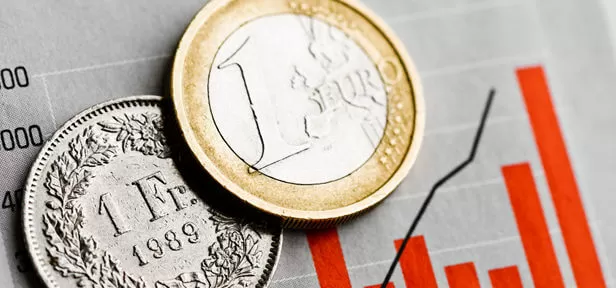Exchange rates by transaction type
If you would like a detailed breakdown of the rates used by many Swiss banks for different kinds of foreign currency transactions, enter your email address in the field below and click on “Request free PDF”.

Swiss banks use two different exchange rates for different kinds of foreign currency exchange transactions. Learn what banknote rates and forex rates are and when they apply with this in-depth moneyland.ch guide.
Rather than using a single set of currency exchange rates, Swiss banks use two separate sets of exchange rates. These two different rates are known as the banknote rate and the forex rate. Each of these rates has its own set of buy rates and sell rates for each currency available for exchange.
The banknote rate (also known as the cash rate) is typically used for currency exchanges performed at bank tills and in-network ATMs. The forex rate, also referred to as the currency rate or the nominal rate, is used when currencies are exchanged as part of wire transfers, debit cards and credit card transactions and securities transactions. Banks generally add a bigger markup to banknote rates than to forex rates.
Both the banknote rate and the forex rate are made up of a lower buy price (bid price) and a higher sell price (ask price). The sell price is the most relevant to consumers because this is the price which consumers pay for foreign currencies when they exchange money at the till or use their credit card or debit card to pay or to withdraw money at ATMs outside of Switzerland.
The difference between the buy price and the sell price is known as the spread. The spread can be measured as a percentage of the sell price using the formula: spread = (sell price - buy price) / sell price. The difference between the sell price and the interbank rate is normally equal to approximately half of the buy/sell spread.
Banknote rates have significantly higher spreads than forex rates. Euro exchange rates have the lowest spreads, followed by the U.S. dollar and the British pound.
Currency exchange rates and spreads vary broadly between currency exchange service providers. They can also vary significantly depending on the currency being purchased, the amount being exchanged, and whether the banknote rate or the forex rate is used for the exchange, as revealed by a moneyland.ch study of currency exchange rates used by Swiss banks.
However, currency exchange rates and spreads are not the only factors which determine which currency exchange service is the most affordable because different rates may be used depending on the type of transaction being made and the amount transacted. It is also important to note that additional fees may apply to certain kinds of foreign currency transactions.
Banknote rate or forex rate?
Whether the banknote rate or the forex rate is used for a foreign currency transaction depends on the kind of transaction being made. You can request a detailed breakdown of which rate is used by many Swiss banks for each kind of transaction at the foot of this guide. Swiss banks generally use the banknote rate for currency exchanges performed at the till – by both customers and non-customers. The banknote rate is also generally used for foreign currency orders delivered to your door (many banks use the Swiss Bankers banknote rate for this service). The forex rate is always used for direct transfers between bank accounts and for securities transactions.
The way in which rates are applied to cash withdrawals at ATMs is more complicated. The less-favorable banknote rate is typically used for foreign currency withdrawals made at in-network ATMs operated by the drawer’s bank using a debit card (a Maestro, Postcard or V-Pay card, for example). The more-favorable forex rate is often used when bank customers make foreign currency withdrawals at out-of-network ATMs in Switzerland. The forex rate is used by most Swiss banks for cash withdrawals at ATMs outside of Switzerland. Because of this, withdrawing foreign currency at out-of-network ATMs sometimes works out cheaper than getting foreign currency at your bank’s till or ATMs, in spite of out-of-network withdrawal fees.
There are a number of exceptions. Some Swiss banks like Raiffeisen, AEK Bank, the Basler Kantonalbank and Bank Cler use their forex rates rather than their less-favorable banknote rates for foreign currency withdrawals at their own ATMs. The Banque Cantonale de Genève (BCGE) uses a special ATM exchange rate. On the flip side, there are also Swiss banks which use banknote rates for foreign currency withdrawals at in-network and out-of-network ATMs. In some cases, foreign ATM operators may apply their own exchange rates to withdrawals made using their ATMs.
Frequency of rate changes
The intervals at which currency exchange rates are updated varies between service providers. Some banks like Raiffeisen, the Berner Kantonalbank and the AEK Bank update their exchange rates every 10 to 15 minutes. Some, like Credit Suisse (forex rate) update rates on an hourly basis, while some update rates 6 times per day (the Luzerner Kantonalbank, for example), 4 times per day (Valiant Bank), at least 3 times per day (Banque Cantonale Vaudoise), twice per day (Schaffhauser Kantonalbank) or once a day (PostFinance). Frequency of rate updates may vary depending on financial markets and on the type of rate used for a transaction. Most banks offer the same rates at all of their branch offices but rates at UBS, for example, can vary between individual branch offices. The Migros Bank, which uses different rates at its Geneva branches, is another exception.
Volume-specific rates
Some banks use the same rates for all currency exchanges regardless of the amount being exchanged. Many Swiss banks, however, use multiple exchange rates, with the amount being exchanged determining which rate is applied. The rule of thumb is: The larger the amount being exchanged, the more favorable the exchange rate used. Many banks offer more favorable currency exchange rates starting from amounts as low as 2000 or 5000 Swiss francs. Special rates may apply to large transactions above 50,000 francs, 250,000 francs or 1 million francs, for example.
Foreign transaction fees compared
Swiss banks do not charge commissions when their customers make foreign currency withdrawals from Swiss franc accounts at banknote rates at the till. Non-customers, on the other hand, are often charged a commission for currency exchanges (5 or 10 francs, for example). Foreign currency withdrawals from Swiss franc accounts using in-network ATMs operated by the drawer’s bank using debit cards are typically commission-free.
Fees are levied by most Swiss banks for foreign currency withdrawals at out-of-network ATMs (the forex rate is typically used for these). Many banks charge a fee of 5 francs when customers withdraw foreign currency at ATMs operated by other service providers (fees vary between banks). Foreign transaction fees – typically 5 francs per withdrawal – are charged by most Swiss banks for cash withdrawals made at ATMs outside of Switzerland. ATM operators may also charge fees for the use of their ATMs.
Getting the best currency exchange rates
The exchange rate is not the only factor to consider when determining the best bank for currency exchanges. Additional fees and charges are just as important. This example using the Zürcher Kantonalbank (ZKB) shows relevant factors by transaction type: A ZKB customer buying 200 euros at the average rate recorded by moneyland.ch (currency exchange analysis 2018) would pay 238.20 Swiss francs at a ZKB till or ATM (which use the banknote rate), around 240.60 francs at an out-of-network ATM in Switzerland (including the out-of-network withdrawal fee of 5 francs plus 0.5%) because the forex rate is used, and are also around 240.60 francs at ATMs outside of Switzerland (including foreign transaction fee of 5 francs plus 0.5%).
If a ZKB customer purchased 400 euros or more, it would be cheaper for them to withdraw the euros from a foreign ATM at the forex rate than to withdraw the euros from a ZKB ATM at the banknote rate. This threshold is lower for withdrawals in other currencies. Withdrawing 180 U.S. dollars or more, 100 British pounds or more, 3400 Thai baht or more, or around 800 Swedish kronor or more at ATMs in the corresponding country is cheaper than purchasing the foreign currency at a ZKB till, as long as no third-party ATM fees apply.
The situation is similar at other banks, although exchange rates, fees and transaction types all determine which option is cheaper. Thresholds may also be higher, as is the case with Valiant Bank. Withdrawing foreign currency at a foreign ATM at the forex rate only works out cheaper than exchanging money at a Valiant branch office at the banknote rate if you buy more than 280 U.S. dollars, 200 British pounds, 2200 Thai baht or 2300 Swedish kronor.
As a general rule, withdrawing euros from foreign ATMs only works out cheaper if you withdraw a large amount, even though the forex rate is used. However, the difference in the cost of buying euros at banknote rates in Switzerland or withdrawing euros at forex rates from foreign ATMs is relatively small.
In the case of less widely circulated currencies, withdrawing large amounts of foreign currency at foreign ATMs is normally cheaper, as long as the money is withdrawn from a bank-operated ATM using a debit card. Important: Always use a debit card and not a credit card to make cash withdrawals from ATMs.
When you use payment cards to pay or to make withdrawals in foreign currencies, always perform the transaction in the local currency rather than in Swiss francs (in which case dynamic currency conversion is used). For large transactions, using a debit card to pay at POS terminals can work out cheaper than withdrawing cash at ATMs because you pay a lower fee and still benefit from the lower forex rate.
More on this topic:
Swiss Bank Currency Exchange Rate Comparison
If you would like a detailed breakdown of the rates used by many Swiss banks for different kinds of foreign currency transactions, enter your email address in the field below and click on “Request free PDF”.
Cheap bank accounts with card
Yuh
No account fees
Banking partner: Swissquote & Postfinance
CHF 20 trading credit with code «YUHMONEYLAND»
UBS key4
50 KeyClub points as a welcome gift
Online private account with debit card
Brokers with low fees
FlowBank
Swiss online bank
No additional exchange charges
No transaction fees for Swiss equities
Saxo Bank Switzerland
Swiss online bank
Favorable prices stock trading
High account interest rates
Cornèrtrader
Swiss online bank
No custody fees for stocks
Free market research and trading signals
Leading credit cards
Swisscard Cashback Cards Amex
No annual fees
Two cards Amex & Visa/Mastercard
With cash back
Migros Cumulus Visa
No annual fees
With Cumulus points
Without foreign currency fees
